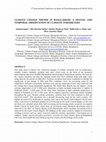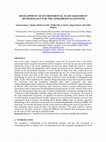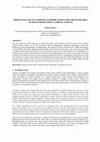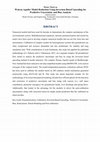Papers by Sani ruz zaman

This study aims to observe the historical changes in climatic variables such as temperature, rai... more This study aims to observe the historical changes in climatic variables such as temperature, rainfall, relative humidity, sunshine hour and cloud cover on the basis of the measured meterological data from 34 BMD (Bangladesh Meteorological Department) stations. Not only for the country summary, but also the regional trends have been analized along with majir cities using data for the period of 1960-2011. Pearson corelation have been coinducted to identify the significants of the change in 90% and 95% confidence level. An increasing trend for all temperature indicators (maximum, minimum and average temperature) have been observed and the change have found statistically significant. The South West Region has the highest yearly average temperature (1.33 oC/100 year). Maximum of daily maximum temperature is highest in Sitakunda (8.633 o C/100 year). On the other hand, maximum of daily minimum temperature is highest in Kutubdia (2.5 33 oC/100 year). All the regions experience maximum relative humidity throughout the year. Another climate parameter, sunshine hour has been analyzed to find out historical trends. This parameter has a decadal decreasing trend for the entire country. The highest decrease (0.52 hr/decade) in sunshine hour was in the North Central Region. On the other hand, it decreases in minimum quantity (0.52 hr/decade) in the South Central Region. In the case of cloud cover, decadal values show both increasing and decreasing trends, except for two regions (South Central & South East), which have an increasing trend. Maximum decreasing trend is observed in the River & Estuary Region (0.93 Okta/decade) while maximum increasing trend is observed in the South Central Region. The findings of this study would be helpful to researchers working in sectors such as: water resources, fisheries, forestry, agriculture, environment etc. In addition, climate experts and policy governens can also set a base climatic status of Bangladesh and cross check model derived climate projection results with the findings of this study.
Keywords: Climate Change, Historical Trend, Statistical Significance, Temperature, Rainfall.

The world’s largest mangrove forest, Sundarbans, along with the brackish water in the deltaic sys... more The world’s largest mangrove forest, Sundarbans, along with the brackish water in the deltaic system and unique estuarine environment with the mangrove forest has become one of the richest biodiversity zones in the world. Sundarbans covered near about 10,000 km2 which is shared between India (40%) and Bangladesh (60%) though the ecosystem of the Sundarbans cannot be divided by the international boundary. A reach number of study have been conducted on the biodiversity and the threaten animals of the Sundarbans but very few of them have focused on the demand of fresh water flow of this entire ecosystem. This study aims to develop a consensus methodology to assess the environmental flow (e-flow) for entire Sundarbans of Bangladesh and India. As the e-flow is defined as the quantity, timing and quality of water flows required to sustain the ecosystems and the livelihoods depended upon these ecosystems, four basic methodologies(Hydrological, Hydraulic Rating, Habitat Simulation and Holistic Approach)defined by Tharme, 2003, have been extensively desk reviewed as well as previous and present e-flow assessments studies conducted in both Bangladesh and India and also in other countries of the world have been incorporated under this study. A number of stakeholder consultation meetings have been conducted in both Bangladesh and India along with relevant experts. Considering the context of the study (Sundarbans ecosystem), acceptability & technical feasibility of the method and data inventory (quality & quantity) and scientific robustness the overall synchronization of reviews and consultations lead to propose the Building Block Method (BBM) under the Holistic Approach Methodology with a customized version named as Customized Building Block Method (CBBM). This study have concurrently developed a further study framework defining the scope of work and the e-flow component matrix along with direct and indirect indicators. This study could be a pioneer research for the policy directives considering IWRM for environmental flow maintenance special for the issue of water shearing in negotiation table.
Keywords:Mangrove, Sundarbans, Environmental Flow, Ecosystem, Building Block Method

Proceedings of the 2ndInternationalConference on Civil Engineering for Sustainable Development (ICCESD-2014), 14~16 February 2014, KUET, Khulna, Bangladesh, Feb 16, 2014
The main objective of this study was to obtain the extreme event analysis of trends in nine count... more The main objective of this study was to obtain the extreme event analysis of trends in nine country relevant annual extreme indices for all the seven Haor districts (Sunamganj, Habiganj, Maulvibazar, Netrakona, Kishorgonj, Sylhet, Brahmanbaria) of Bangladesh. The analysis have been obtained for four BMD metrological stations (Sylhet, Srimongal, Mymensing and Comilla) with a historical time span of near about 50 years (1960 to 2008) to represent the whole Haor area. The software used to process the analysis was the RClimdex 1.0. Long term daily rainfall and temperature (maximum and minimum) data have been used to prepare the input dataset for the software and data has been quality controlled and tested for homogeneity, before they were used for calculation of indices. The analysis has identified that the temperature increased for some extreme indices (SU25) in Haor area by the last half of the century. Moreover other climatic indices showed that the rainfall intensity in Haor area was also increasing for last 50 years.
Thesis Chapters by Sani ruz zaman

Numerical models had been used for decades to demonstrate the complex mechanisms of the environme... more Numerical models had been used for decades to demonstrate the complex mechanisms of the environmental system. Multidimensional equations, intricate parameterization and sensitivity matrix have been used to develop complex numerical models that are not free from bias and uncertainties. Calibration of complex models for heterogeneous systems like groundwater are often complicated and resource demanded and also problematic for stability and long simulation time. With consideration of such limitations, this study has applied the published methodology of J. Doherty and S. Christensen, 2011, on a regional complex 3D groundwater flow model to analyse the predictive uncertainty and bias by using the inversion based upscaling method of model reduction. The complex Wairau Aquifer model of Marlborough, New Zealand has been reduced to develop simplified models using MODFLOW, to be used as surrogate of the original model. The model-independent parameter estimation software PEST has been used to calibrate the models based on 200 synthetic model realizations generated numerically using MATLAB and R. This study has stated important remarks for the methodology of inversion based paired modeling. Results have offered options for the detection and correction of predictive uncertainty and bias along with sources (i.e., null space contribution, parameter surrogacy) for groundwater heads, river discharge and spring flows. Additionally, that leaded to the advantage for the modeler to detect the post-calibration uncertainties along with correction based on simple model prediction that has calibrated on observed data.
Key words: Parameterization, Calibration, Inversion Based Upscaling, Predictive Uncertainty, Bias, Realizations, Paired Modeling and Post-calibration







Uploads
Papers by Sani ruz zaman
Keywords: Climate Change, Historical Trend, Statistical Significance, Temperature, Rainfall.
Keywords:Mangrove, Sundarbans, Environmental Flow, Ecosystem, Building Block Method
Thesis Chapters by Sani ruz zaman
Key words: Parameterization, Calibration, Inversion Based Upscaling, Predictive Uncertainty, Bias, Realizations, Paired Modeling and Post-calibration
Keywords: Climate Change, Historical Trend, Statistical Significance, Temperature, Rainfall.
Keywords:Mangrove, Sundarbans, Environmental Flow, Ecosystem, Building Block Method
Key words: Parameterization, Calibration, Inversion Based Upscaling, Predictive Uncertainty, Bias, Realizations, Paired Modeling and Post-calibration